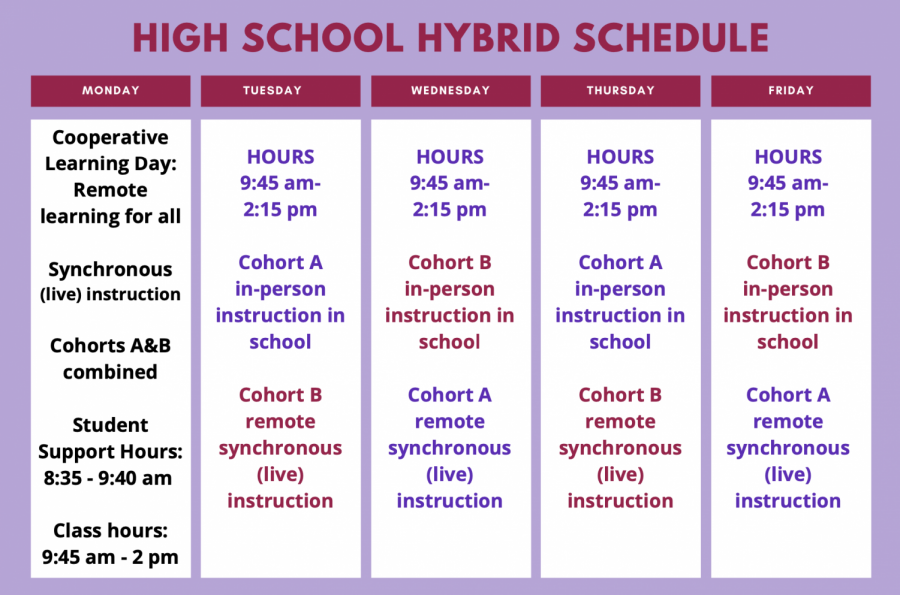Assessing the weaknesses and strengths of the new hybrid schedule
High school students will either return to school or stay at home following this new schedule.
The Cherry Hill School District has decided to start hybrid learning on November 17, 2020, and they have given the parents and students the opportunity to decide whether they want to attend school through the hybrid model, or if they want to continue full remote until at least the end of the semester in February.
Morgan Jones (‘21) says that the hybrid model is a reasonable opportunity for students who want to attend school in-person. She also said that although she is excited, she “feels nervous about attending in person” since she is afraid of catching the virus. Jones said that she has around 15 students in her classes like art, which usually has more students if we were under normal circumstances. Jones said that the strength of the system is that students are given the opportunity to go in-person. The weakness is that not all students are going. Jones added that not as many students that chose in-person during September are sticking to that, since she heard that initially 70% of students chose the hybrid model, but now only 50% are going. Jones said that overall, she is excited and anxious about going back in-person.
Emma Hildebrand (‘21), said she “would say that the hybrid schedule is kind of confusing to understand.” Hildebrand added that not as many students are attending in-person learning through the hybrid model. There are a minimum of about six students in some of her classes, and at most about ten students in other classes. Small classes keep students focused, Hildebrand said. She feels that the overall weakness of hybrid learning is the fact that Covid-19 is still going around. She wonders how students will maintain their safety while in the building. Hildebrand said that it would be a challenge to ensure that students will continue to wear their masks while in the building, especially for the younger students who are attending school.
Julia Spivack (‘21), said that she has not “thought about anything other than the current schedule that would maintain a way for students to return back in-person.” She says that she wishes that all students would be remote on Wednesday and that Cohort A students would be attending in-person on Mondays and Tuesdays, and for Cohort B students to be attending in-person classes on Thursdays and Fridays. She says that this way, there will be time in between for the building to be cleaned before the next group comes in. Spivack said that she “did not think that a majority of the students would be attending in-person, nor think that a majority would be sticking to remote learning.” Reducing the amount of students attending in-person and the amount of time spent in school are major strengths, Spivack said. Spivack feels that the weakness of hybrid learning is just how teachers are going to teach online and in person at the same time. She said that she feels nervous, but also relieved to go back and return to a sense of normalcy.
Gaby O’brien (‘21), said that she has “mixed thoughts, in that there is excitement to see people, but also anxiousness to go back in-person.” O’brien said that the main strength of the hybrid model is the fact that there is an opportunity to go back to school in the first place. O’brien said she “personally learns better when in school.” She said that most of her friends who were initially going to attend in person have changed back to remote, and vice versa. O’brien feels that the major weakness of the hybrid model is food. The fact that students are unable to eat in school is going to be tough, O’brien said. Information sent out to students and parents is vague, therefore making the situation a bit confusing, O’brien said. Also, O’Brien is unaware of how many students will be in her class, and that she is assuming that it must depend on whether a student is in Cohort A or B.
Pete Cuddihy (‘21), said that he is very excited to go back to in-person learning. He said that “it is very hard to learn online.” Cuddihy said that not as many students are going to attend in-person classes, mainly because students are not given the opportunity to eat lunch. Cuddihy added that the start and end time of school is very much liked by many students. He also said that some of the strengths of the hybrid system is that there is a cleaning period, which will allow for the schools to maintain safety. The system has its weaknesses, in that no one knows how education will be for the students attending in person or staying remote, Cuddihy said. He added that the class times are significantly shorter, which means that more school work will have to be done outside of school as he said that class sizes will be one third of what they normally are. Cuddihy added that overall he is “excited to go back and see a change in scenery.”


